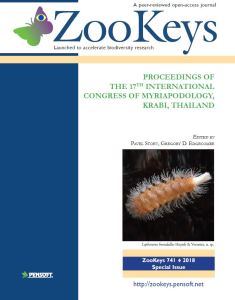While working on a rare little known group of Oriental wasps that most likely parasitise the eggs of grasshoppers, locusts or crickets, not only did a team of four entomologists discover four previously unknown species, but they also found that another four species within the same genus (Habroteleia) were in fact all one and the same – a fifth species discovered more than a century ago.
Their study, published in the open access journal Zookeys, comes as a fine example illustrating the important role played by taxonomists in puzzling out the Earth’s biodiversity.
The research was conducted by doctorate candidate Huayan Chen and Dr. Norman F. Johnson, both affiliated with The Ohio State University, USA, Dr. Elijah J. Talamas, Florida Department of Agriculture and Consumer Services, USA, and Dr. Lubomír Masner, Agriculture and Agri-Food Canada.
Prior to their study, there were only nine species known in the genus that had been described over the last 113 years from India, Japan and the Philippines.
However, following careful analyses, most of those species turned out to be synonyms of another one discovered in distant 1905, H. flavipes. Because of this species having been described and named five times in total through the years, the richness of the genus has been greatly inflated.
In their turn, having identified four new species belonging to the same genus after studying additional material collected from Madagascar, Papua New Guinea, and the Fijian archipelago, the scientists have maintained the species number in the group intact.
Additionally, the team provides a detailed illustrated identification key to all members of the genus in their paper. This list of characteristic features is set to prevent similar taxonomic confusion in the future.
In conclusion, Chen and colleagues have significantly advanced our understanding of the diversity and biogeography of the rare parasitoids, amongst which there might be some that will eventually prove to be helpful in pest management.
“Taxonomic revisions are essential for the fundamental understanding of biodiversity and its conservation. Taxonomists play a critical role in this process,” explains the lead author.
###
Original source:
Chen H-y, Talamas EJ, Masner L, Johnson NF (2018) Revision of the world species of the genus Habroteleia Kieffer (Hymenoptera, Platygastridae, Scelioninae). ZooKeys 730: 87-122. https:/






 A dedicated
A dedicated 


 In conclusion, the authors note that given the latitude they discovered all of the studied moths, it is highly likely that more species belonging to the newly described genera are pending discovery in the adjacent countries – especially India.
In conclusion, the authors note that given the latitude they discovered all of the studied moths, it is highly likely that more species belonging to the newly described genera are pending discovery in the adjacent countries – especially India.
 The scientists remind that, back in 1972, when Anthony Burgess explained the title of his famous novel A Clockwork Orange, he said: “I’ve implied the junction of the organic, the lively, the sweet – in other words, life, the orange – and the mechanical, the cold, the disciplined (…)”
The scientists remind that, back in 1972, when Anthony Burgess explained the title of his famous novel A Clockwork Orange, he said: “I’ve implied the junction of the organic, the lively, the sweet – in other words, life, the orange – and the mechanical, the cold, the disciplined (…)”

 Wood says pelican spiders are well known among arachnologists not only for their unusual appearance, but also for the way they use their long “necks” and jaw-like mouthparts to prey on other spiders. “These spiders attest to the unique biology that diversified in Madagascar,” she said.
Wood says pelican spiders are well known among arachnologists not only for their unusual appearance, but also for the way they use their long “necks” and jaw-like mouthparts to prey on other spiders. “These spiders attest to the unique biology that diversified in Madagascar,” she said.

![Ochyrocera varys predating on a fly [Fig. 21 A]](https://i0.wp.com/blog.pensoft.net/wp-content/uploads/2018/01/Ochyrocera-varys-predating-on-a-fly-Fig.-21-A.jpg?resize=300%2C225) The list of ‘fantasy’ spiders begins with Ochyrocera varys named after Lord Varys from George R. R. Martin’s book series A Song of Ice and Fire. Lord Varys is also known as the Spider because of his manipulative skills and ability to ‘weave’ and command his networks of eyes-and-ears across two continents.
The list of ‘fantasy’ spiders begins with Ochyrocera varys named after Lord Varys from George R. R. Martin’s book series A Song of Ice and Fire. Lord Varys is also known as the Spider because of his manipulative skills and ability to ‘weave’ and command his networks of eyes-and-ears across two continents.![A couple of Ochyrocera misspider [Fig. 21 C]](https://i0.wp.com/blog.pensoft.net/wp-content/uploads/2018/01/A-couple-of-Ochyrocera-misspider-Fig.-21-C.jpg?resize=300%2C225)

 “We think that the new species, Antipathozoanthus obscurus, has evolved away from needing to be on top of black corals to take advantage of the available space in coral reef cracks”, said lead researcher Hiroki Kise.
“We think that the new species, Antipathozoanthus obscurus, has evolved away from needing to be on top of black corals to take advantage of the available space in coral reef cracks”, said lead researcher Hiroki Kise.